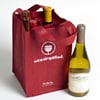Commonly referred to as the five S's—see, swirl, sniff, sip (and swish) and spit/savor—the steps of wine-tasting are not only pretty simple, but also help you get the most pleasure out of what's in the glass.
See
 Wines come in two basic colors, but look closely and you'll see beyond red and white—and the variations you spot will be telling. To best gauge a wine's color, tilt the glass and look down through the wine, preferably against a plain white surface. Here's what you're looking for:
Wines come in two basic colors, but look closely and you'll see beyond red and white—and the variations you spot will be telling. To best gauge a wine's color, tilt the glass and look down through the wine, preferably against a plain white surface. Here's what you're looking for:
- Depth of Color - The darker the hue, the more intense you can expect the flavor to be. Pale Pinot Grigio is ultralight; a heavier, oak-aged Chardonnay appears deep gold. A translucent, garnet-shaded red is apt to be simple and fruity, whereas an opaque purple one will taste dense.
- Clarity and Beauty - Is the wine clear, as in free of cork or sediment? Is it visually appealing? As wines age, they gradually begin to brown (a natural sign of oxidation). An amber white table wine is probably over the hill; reds will tend to appear brackish along the edges as they pass five years.
- Nice "Legs" - Those trails of wine streaming down the sides of the glass (called "legs" or "tears" by the French) are a sign of fuller body and viscosity—but not necessarily quality.
Swirl
 This is the step of wine tasting that often gets flagged as snobbish, but it's actually quite functional. Swirling is merely a setup for smelling the wine. In short you smell vapor, not liquid. By swirling the class you create more vapor and thus make it easier to catch a good whiff of all the wine has to offer.
This is the step of wine tasting that often gets flagged as snobbish, but it's actually quite functional. Swirling is merely a setup for smelling the wine. In short you smell vapor, not liquid. By swirling the class you create more vapor and thus make it easier to catch a good whiff of all the wine has to offer.
If you are not used to swirling your beverage, just keep it on the table—it's way easier that way. Clockwise or counter-clockwise doesn't matter. If you still find it hard to pic up aromas, keep your hand on top of the glass while swirling.
Hold the glass by the stem while swirling; it's easier to balance that way, and in doing so your hands won't warm up the bowl of the glass (and hence, the wine inside). On the other hand, if a white wine is too cold and the aromas seem muted, you may want to swirl a few times with a hand (or two) around the bowl of the glass.
Sniff
 Now it's time to get down to business. Smelling the wine before you taste it is a way to get a sneak preview of what the wine has in store. In fact, because the human sense of smell is more acute and precise than our sense of taste, you actually may find more in a wine at this stage than when actually sipping. Moreover, your sense of smell is integral to the tasting process—as becomes clear when you have a cold and everything you eat or drink seems muted.
Now it's time to get down to business. Smelling the wine before you taste it is a way to get a sneak preview of what the wine has in store. In fact, because the human sense of smell is more acute and precise than our sense of taste, you actually may find more in a wine at this stage than when actually sipping. Moreover, your sense of smell is integral to the tasting process—as becomes clear when you have a cold and everything you eat or drink seems muted.
Of course, the act of smelling is a no-brainer, but what you are aiming to do with wine is to discern nuances. The real trick at this stage is to concentrate and keep an open mind at the same time.
Aromas can come in distinctly different types. "Fruity" is the most obvious category, ranging from stone fruits like peaches to citrus and berries. But aromas of vegetables, herbs, minerals, even chemicals are common (see Aromas and Flavors for more terms that may help you find just the descriptor you're looking for as you sniff). That's the magic of wine: Grapes can be amazingly un-grapelike once they are fermented and given some time.
Some tasters like to take in the aromatics of a wine in long, steady whiffs; others believe a series of short sniffs reveals more. Whites tend to be less potent in the aroma department, which is one reason why small-bowl glasses are used, focusing the wine's vapor.
Sip/Swish

Finally. Take that sip. A nice, big one, and let it roll all over your tongue. Swish it around, even "chew" it a little and draw in a bit of air. What you're doing at his stage is making sure you get the maximum impact of both the wine's flavor and texture. Research suggests that we have different taste sensitivities on different parts of our tongue (sweetness at the tip, acidity on the sides, bitterness toward the back). Rolling the wine around is not the most natural of acts, but it will give you a wine's whole story, so to speak.
Again, concentration and an open mind are key. Flavors may reveal themselves in layers, as in berries, then pepper. At this stage you'll also want to gauge the relative body or weight of the wine (light to full), as well as the texture (soft, sharp, rough, etc.).
Spit/Savor
 Spitting is not necessary of course; savor works just as well in the five S's theme. Regardless of which way you go, the key at this stage is assessing the wine's finish.
Spitting is not necessary of course; savor works just as well in the five S's theme. Regardless of which way you go, the key at this stage is assessing the wine's finish.
Think of this as the wine's epilogue. Flavors in a good wine will linger. Ask yourself it the aftertaste is pleasant and whether the finish is short or long. A crisp, tangy wine may actually make you salivate after the wine is gone; a big, tannic red may leave you feeling pucker.
Spitting is the best way to keep your palate sharp and your head clear if you are tasting multiple wines. It's not the way we're used to drinking, but one of the remarkable things about wine is how much you can sense without actually swallowing. (Tip: for spittoons, use either an opaque bucket such as a Champagne chiller, or tall, colored plastic cups for individuals, and use a paper towel to discreetly muffle the sound of spitting your wine in the bucket.)
See Wine Defined for words to help you describe what you're experiencing.

 You are about to leave publix.com and enter the Instacart site that they operate and control. Publix’s delivery and curbside pickup item prices are higher than item prices in physical store locations. Prices are based on data collected in store and are subject to delays and errors. Fees, tips & taxes may apply. Subject to terms & availability. Publix Liquors orders cannot be combined with grocery delivery. Drink Responsibly. Be 21. For prescription delivery, log in to your pharmacy account by using the Publix Pharmacy app or visiting
You are about to leave publix.com and enter the Instacart site that they operate and control. Publix’s delivery and curbside pickup item prices are higher than item prices in physical store locations. Prices are based on data collected in store and are subject to delays and errors. Fees, tips & taxes may apply. Subject to terms & availability. Publix Liquors orders cannot be combined with grocery delivery. Drink Responsibly. Be 21. For prescription delivery, log in to your pharmacy account by using the Publix Pharmacy app or visiting 
